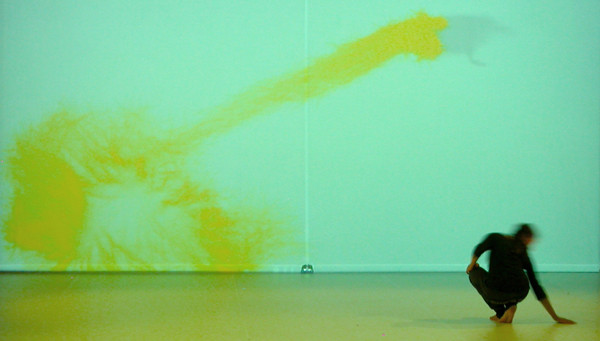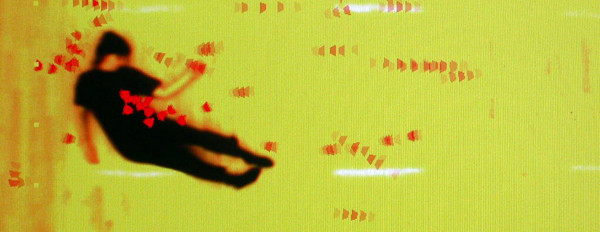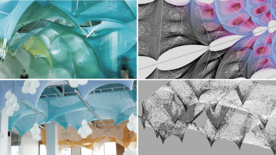
Sea UnSea

A research project by CITA and the Bartlett School of Architecture, Program of Virtual Environments
Sea UnSea is an interactive dance-architecture conceived by between architect Mette Ramsgard Thomsen and choreographer Carol Brown and developed in collaboration with Chiron Mottram and Alan Penn from the Virtual Reality Centre for the Built Environment, Bartlett School of Architecture, University College London.
Sea UnSea takes place on an interactive stage informed by a camera interface. On an empty floor and beneath a slanted cloud canopy, four performers begin by simply walking. As they cross the floor, their movements affect a sonorous field of sound while tides of virtual sea meadows are projected onto the canopy above. Capturing the fleeting forms of this virtual sea, the performers play and explore, attracting, repulsing and entwining their bodies and voices within the evolving patterns of a swirling hynotic synthetic sea. Testing the physical and emotional thresholds that separate them from the rootless sea meadow the work develops through repetitive tides of action. Across time the sea gradually evolves as a growing ecology embedding the presence of the performers as mnemonic traces within a dense field.

Sea UnSea asks how space can be understood as a fluid condition attaining responsive properties through intelligent programming. Sea Unsea examines the making of a digital environment that attains the ability to learn back. Developed in collaboration with Alan Penn and Chiron Mottram at the Virtual Reality Centre for the Built Environment, Bartlett School of Architecture, University College London, the project develops intelligent crowd visualisation software, otherwise used to visualise movement in the built environments.
A camera interface informs a dynamic digital environment, shaped by the emergent behaviours of the agents. The agents can be understood as a swarm of digital beings that interact with each other as well as react to changes in their environment. Defined by low-level rules that lead to the emergence of a high-level patterning, the agents inhabit the two dimensional surface of the camera picture plane. As they seek to navigate the plane, drawn by defined points of attraction, and hindered by shades of darkness, they encounter the performers, negotiating their presence, confronting, traversing, intersecting, evading, and inhabiting their image.

About the Work
"What we see on the screens is a mass of multiplying shapes and forms, like ink on blotting paper, constantly spreading, disappearing, then growing all over again. When the dancers, Marina Collard, Anna Williams and Matthew Smith enter the performing space, the visual imagery, the colored shapes which begin to take on the appearance of a living organism, tracks their movement; so it appears to follow the performers as they dance, reacting to their changes of direc¬tion and tempo, continuously metamorphosing into new shapes and forms…. The effect … is highly emotive and even visceral…. Thomsen’s patterns resemble growing organisms, swarming insects, unfurling blossoms, rapidly spreading coral reefs.... Images from nature and the restless, timeless sea….The organic (the live movement) and the toxic (the images generated by Thomsen’s computer) share this environment in which nothing is fixed and everything is unstable. The different colors which appear on the screens are enhanced by Michael Mannion’s lighting design, while an oceanic sound-score by Alistair MacDonald helps create a sense of shifting emotional states -- love, grieving, anger, yearning and provocative memories."
- Josephine Leask, Flash Journal, 11-3: Carol Brown Rides the Tech Wave.

Performances
Sea UnSea was premiered as part of the international dance festival Dance Umbrella at Siobhan Davies Dance Centre, London. 12 Oct – 15 Oct 2006. Research showing were performed at Finding Fluid Form Symposium at University of Brighton, 9 Dec 2005 andDigital Cultures Lab, Radiator Festival, Nottingham, 28 Nov 2005.
A performance lecture was performed as part of the London Architectural Biennale, June 2006: Dancing-drawing: towards a dance-architecture. Workshops were held at Critical Path, Sydney and Perth Institute for Contemporary Art, Oct 2007.
The project was supported by Arts Council London and was undertaken in collaboration with and with support from CITA, University of Brighton, School of Architecture and Design, Virtual Environements, University College London.
Concept and architecture
Mette Ramsgard Thomsen
Choreography
Carol Brown
Coding
Chiron Mottram and Teis Draiby
Lighting
Michael Mannion
Music
Alistair McDonald














